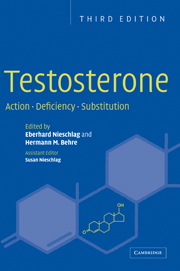Book contents
- Frontmatter
- Contents
- List of contributors
- Preface
- 1 Testosterone: an overview of biosynthesis, transport, metabolism and non-genomic actions
- 2 The androgen receptor: molecular biology
- 3 Androgen receptor: pathophysiology
- 4 Behavioural correlates of testosterone
- 5 The role of testosterone in spermatogenesis
- 6 Androgens and hair: a biological paradox
- 7 Androgens and bone metabolism
- 8 Testosterone effects on the skeletal muscle
- 9 Androgens and erythropoiesis
- 10 Testosterone and cardiovascular diseases
- 11 Testosterone and erection
- 12 Testosterone and the prostate
- 13 Clinical uses of testosterone in hypogonadism and other conditions
- 14 Pharmacology of testosterone preparations
- 15 Androgen therapy in non-gonadal disease
- 16 Androgens in male senescence
- 17 The pathobiology of androgens in women
- 18 Clinical use of 5α-reductase inhibitors
- 19 Dehydroepiandrosterone (DHEA) and androstenedione
- 20 Selective androgen receptor modulators (SARMs)
- 21 Methodology for measuring testosterone, DHT and SHBG in a clinical setting
- 22 Synthesis and pharmacological profiling of new orally active steroidal androgens
- 23 Hormonal male contraception: the essential role of testosterone
- 24 Abuse of androgens and detection of illegal use
- Subject Index
12 - Testosterone and the prostate
Published online by Cambridge University Press: 18 January 2010
- Frontmatter
- Contents
- List of contributors
- Preface
- 1 Testosterone: an overview of biosynthesis, transport, metabolism and non-genomic actions
- 2 The androgen receptor: molecular biology
- 3 Androgen receptor: pathophysiology
- 4 Behavioural correlates of testosterone
- 5 The role of testosterone in spermatogenesis
- 6 Androgens and hair: a biological paradox
- 7 Androgens and bone metabolism
- 8 Testosterone effects on the skeletal muscle
- 9 Androgens and erythropoiesis
- 10 Testosterone and cardiovascular diseases
- 11 Testosterone and erection
- 12 Testosterone and the prostate
- 13 Clinical uses of testosterone in hypogonadism and other conditions
- 14 Pharmacology of testosterone preparations
- 15 Androgen therapy in non-gonadal disease
- 16 Androgens in male senescence
- 17 The pathobiology of androgens in women
- 18 Clinical use of 5α-reductase inhibitors
- 19 Dehydroepiandrosterone (DHEA) and androstenedione
- 20 Selective androgen receptor modulators (SARMs)
- 21 Methodology for measuring testosterone, DHT and SHBG in a clinical setting
- 22 Synthesis and pharmacological profiling of new orally active steroidal androgens
- 23 Hormonal male contraception: the essential role of testosterone
- 24 Abuse of androgens and detection of illegal use
- Subject Index
Summary
Introduction
Despite major progress in the biological sciences during the last 50 years, it is rather remarkable that we have entered the twenty-first century and still the specific function of the prostate gland remains unknown. Indeed, the prostate is the largest organ of unknown specific function in the human body. Although it is believed that the prostate is important in protecting the lower urinary tract from infection and for fertility, it is frequently the site of infection and inflammation, and sperm harvested from the epididymis without exposure to seminal or prostatic fluid can produce fertilization and successful birth (Silver et al. 1988). The fact that the specific in vivo function of prostate is not fully understood might not be so problematic if it were not the case that the prostate is the most common site of neoplastic transformation in men, with approximately one in six men in western industrialized nations eventually developing clinically detected prostatic cancer during their lifetime (Jamal et al. 2003). Furthermore, the prostate is the most common site of benign neoplastic disease in males (Berry et al. 1984). More than 50% of all men above the age of 50 have benign prostatic hyperplasia (BPH) with ≈25% of men eventually requiring treatment for this condition (Berry et al. 1984). Thus, it is remarkable that despite the high prevalence of prostatic diseases, the etiologies of neither prostatic cancer nor BPH are known.
- Type
- Chapter
- Information
- TestosteroneAction, Deficiency, Substitution, pp. 347 - 374Publisher: Cambridge University PressPrint publication year: 2004
- 4
- Cited by

